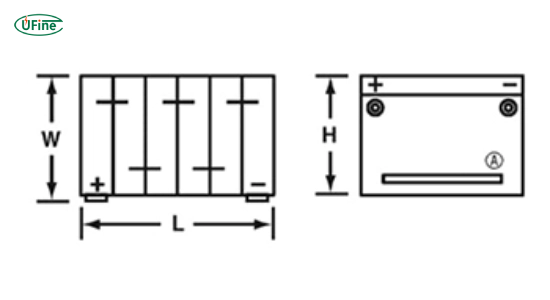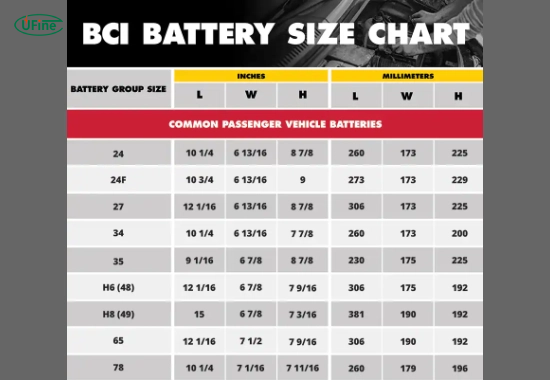
- Part 1. What does battery group size mean in simple terms?
- Part 2. Why is battery group size important?
- Part 3. How do I find my battery group size?
- Part 4. Understanding the battery group size chart
- Part 5. Does battery group size affect performance?
- Part 6. Can I use a different battery group size?
- Part 7. How is battery group size different from battery type?
- Part 8. Battery group size for deep-cycle, marine, and RV batteries
- Part 9. Does a larger battery group size mean better performance?
- Part 10. Tips for choosing the right battery group size
- Part 11. FAQs about battery group size
What does battery group size mean, and why should you even care? If you’ve ever had to replace a car battery, upgrade a marine power system, or shop for a deep-cycle battery, you’ve probably come across this term. Battery group size is crucial in selecting the right battery for your vehicle or equipment.
In simple terms, battery group size refers to a battery’s standardized dimensions and terminal configurations. This ensures it fits correctly in the battery tray and works seamlessly with your vehicle’s electrical system.
Whether you’re a first-time battery buyer or a seasoned gearhead, understanding battery group size will help you make smarter choices, avoid installation issues, and improve performance.
Part 1. What does battery group size mean in simple terms?
Battery group size is a classification set by the Battery Council International (BCI) to describe a battery’s physical dimensions, terminal orientation, and mounting style. This standardized sizing system makes matching batteries with specific vehicles, marine systems, or off-grid setups easier.
Each group size has a unique label, such as Group 24, Group 35, or Group 94R, corresponding to a precise length, width, and height. For example:
- Group 24: 10.25″ x 6.8125″ x 8.875″
- Group 35: 9.1″ x 6.9″ x 8.9″
- Group 94R: 12.4″ x 6.9″ x 7.5″
Choosing the right group size ensures that the battery fits snugly in the tray, the cables reach the terminals, and the electrical system functions properly.
Part 2. Why is battery group size important?
Battery group size isn’t just a technical detail — it’s a functional requirement. Here’s why the correct group size matters:
- Proper fit: A battery that’s too large won’t fit in the tray. One that’s too small may move around, causing damage.
- Correct terminal alignment: If the terminals are on the wrong side, your cables may not reach or could short out.
- Optimal performance: The right size ensures the battery delivers the power your vehicle needs to start and run efficiently.
- Safety: A mismatched battery can lead to overheating, poor connections, and even electrical fires.
Using the wrong battery group size can lead to starting problems, erratic performance, or even void your warranty. Always double-check the group size before buying a new battery.
Part 3. How do I find my battery group size?
Not sure what your battery group size is? Here are a few easy ways to find out:
- Check the old battery
The label or casing of your current battery usually shows the group size (e.g., “Group 35”). - Look in the owner’s manual
Your vehicle’s manual will include the recommended battery specifications, including group size. - Use a battery lookup tool
Websites like AutoZone, Advance Auto Parts, and others allow you to input your car’s make, model, and year to find the correct battery size. - Ask a professional
Mechanics and battery retailers can quickly identify the correct group size using your vehicle’s VIN or other specs.
Part 4. Understanding the battery group size chart
A battery group size chart is a handy tool that lists different group sizes, dimensions, and typical applications. Here’s a sample:
| Group Size | Length (in) | Width (in) | Height (in) | Typical Vehicle Applications |
|---|---|---|---|---|
| 24 | 10.25 | 6.8125 | 8.875 | Cars, light trucks |
| 35 | 9.1 | 6.9 | 8.9 | Honda, Toyota |
| 48 (H6) | 12.1 | 6.9 | 7.6 | Audi, BMW, Mercedes |
| 65 | 12.06 | 7.5 | 7.6 | Full-size trucks and SUVs |
| 94R | 12.4 | 6.9 | 7.5 | European and luxury vehicles |
Using a battery group size chart helps ensure you select the right battery for your tray and terminal layout.
Part 5. Does battery group size affect performance?
Yes, battery group size can influence performance, but not directly. Instead, it affects the battery’s capacity, such as:
- Cold Cranking Amps (CCA): The power to start an engine in cold conditions.
- Reserve Capacity (RC): How long the battery can run electrical systems if the alternator fails.
- Amp-Hour (Ah) Rating: Common in deep-cycle batteries, this tells you how much energy the battery can store.
Larger group sizes often have higher CCA and RC ratings, making them more powerful. However, bigger isn’t always better — it’s about choosing the right size for your needs.
Part 6. Can I use a different battery group size?
You can — but only if the new battery:
- Fits securely in your battery tray
- Matches the terminal type and placement
- Meets or exceeds your required CCA and voltage
For example, if the dimensions and specs are compatible, you might swap a Group 35 with a Group 24F. However, this is not recommended unless you’re confident in the switch or advised by a professional.
Part 7. How is battery group size different from battery type?
It’s easy to confuse battery group size with battery type, but they’re very different:
- Battery group size = external dimensions and layout
- Battery type = internal chemistry and construction
Common battery types include:
- Flooded lead-acid
- AGM (Absorbed Glass Mat)
- Gel batteries
- Lithium-ion
You can have a Group 31 AGM battery or a Group 31 flooded battery — same size, different internal technology. Always check both the group size and battery type before buying.
Part 8. Battery group size for deep-cycle, marine, and RV batteries
In marine, solar, and RV applications, battery group size becomes even more critical because:
- Space is limited
- Power demand is high
- Vibration and temperature conditions are extreme
Common deep-cycle battery group sizes include:
- Group 24: Compact, easy to install
- Group 27: More capacity for moderate use
- Group 31: Offers high amp-hour ratings for extended use
Always match the group size to your storage compartment and power requirements for optimal performance and safety.
Part 9. Does a larger battery group size mean better performance?
It’s a common belief that larger battery group sizes automatically mean better performance, but that’s not always the case.
Yes, a larger group size often has:
- Higher CCA (cold cranking amps)
- Greater reserve capacity
- More amp-hours (in deep-cycle batteries)
But that doesn’t mean it’s the right choice for your system. Here’s why:
- Fitment issues: A bigger battery might not fit in your vehicle’s tray, or may interfere with other engine components.
- Terminal mismatch: The terminal location may not align with your vehicle’s wiring, causing connection problems.
- Charging system limitations: Your alternator may not be designed to charge a higher-capacity battery, leading to undercharging and reduced lifespan.
- Wasted cost: You’re paying more for power you may never use, especially in smaller cars or systems with low energy demands.
The best battery group size is not necessarily the largest — it’s the one that:
- Fits your battery compartment exactly
- Matches your vehicle’s electrical load
- Aligns with your terminal and post configuration
- Matches the specs recommended by your vehicle’s manufacturer
Bigger is not better unless it’s required. Always go with the group size that delivers the right fit, function, and performance balance for your application.
Part 10. Tips for choosing the right battery group size
Here are some pro tips to help you pick the ideal battery group size:
- Measure your battery tray: Check your tray’s length, width, and height before shopping.
- Check cold cranking amps (CCA): Essential in colder climates.
- Use your vehicle’s manual: It’s the most reliable source for recommended specs.
- Compare similar group sizes: Some may offer better terminal orientation or capacity.
- Consult a technician: If in doubt, a battery professional can help you make the right call.
Part 11. FAQs about battery group size
What does battery group size mean?
Battery group size refers to a battery’s standard dimensions and terminal layout, ensuring it fits properly in a specific vehicle or equipment.
How do I find out my battery group size?
You can check the label on your old battery, consult your owner’s manual, or use an online battery lookup tool based on your car’s make and model.
Can I use a different battery group size?
Only if the new size fits your tray, matches the terminal layout, and meets your vehicle’s power requirements. Always consult a professional before switching.
Why does battery group size affect performance?
Group size affects the battery’s ability to deliver and store power. Larger batteries may provide more CCA and reserve capacity, but only if your system supports it.
Are battery group size and battery type the same?
No. Group size relates to the battery’s dimensions and terminal positions; battery type refers to the internal chemistry (AGM, lithium, etc.).
Related Tags:
More Articles

18650 Protected Battery VS Unprotected: Which One Is Better?
Discover the differences between protected and unprotected 18650 batteries. Learn which type offers better safety and performance for your device.
How to Choose the 18650 Vape Battery?
How to choose the 18650 vape battery? Deciphering capacity, discharge rates, and compatibility. This guide equips users with insights for informed decisions.
18650 Battery 2600mAh: Specifications, Recommend, Applications
18650 batteries: rechargeable lithium-ion used in electronics. 2600mAh variant known for longevity, high energy density, reliable performance.
Top 10 11.1V LiPo 3S Battery Models in 2025
Explore our curated list of the 10 best 11.1V 3S LiPo batteries. Find reliable options that enhance your devices' performance and longevity.
How Long Do Rechargeable Vape Batteries Last?
Learn about the lifespan of rechargeable vape batteries, factors that impact their longevity, and tips to keep them performing at their best.




